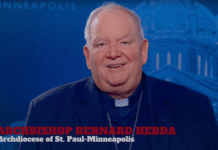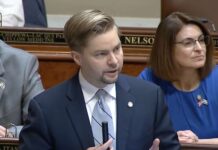Some Hispanic Catholics who attend Our Lady of Guadalupe Church in St. Paul are seeking to remove Fr. Andrew Brinkman as their parish priest for what they say amounts to cultural colonization.
Brinkman, 36, has been at the church since 2016. Initially given an administrative role, he was tapped to lead the parish three years ago in 2018.
According to the Star Tribune, Brinkman has ushered in traditional liturgical practices that offend church-goers.
Some of his actions reportedly include ridding the church of “Aztec dancers,” replacing some Spanish Masses with Latin, banning women from the altar, and minimizing Mexican “traditions” such as the quasi-pagan “Day of the Dead.”
Approximately 50 parishioners held a protest outside the 90-year-old church, which is located on Concord Street, this past weekend in order to force Archbishop Bernard Hebda to take action.
“It’s a sad time at Our Lady of Guadalupe Church,” Debbie Luna, who helped organize the event, posted on Facebook. “Many know and have experienced our problems with our young priest who has ran the church with No regard to many Parishioners concerns. So after no help from the Arch Diocese [sic] it has resorted to this.”
The Star Tribune reported that parishioners first raised concerns about Brinkman four months ago, alleging that he’s too dogmatic and inadequately pastoral.
“He’s not been sufficiently culturally informed,” Abel Piñeiro remarked. His actions have resulted in “a sizable group in our parish being estranged and marginalized.”
Fr. Michael Tix, episcopal vicar for clergy and parish services, has said that the archbishop has been informed of the matter and is involved in conversations with parish leadership.
Although the Catholic Church did make revisions to its liturgy in the 1960s that allowed for more masses to be said in the vernacular language, the norm for over 1,500 years in the Western world was that Latin was the exclusive language used during religious ceremonies.
In 1962, for instance, Pope John XXIII issued an encyclical encouraging the preservation of Latin and its usage.
“Of its very nature Latin is most suitable for promoting every form of culture among peoples,” he wrote. “It does not favor any one nation, but presents itself with equal impartiality to all and is equally acceptable to all.”
This was not always adhered to, however, in the decades that followed. Many post-Vatican II liturgies devolved into what Cardinal Joseph Ratzinger, now Pope Emeritus Benedict XVI, once called “banal on-the-spot” productions that incorporated too many local customs and traditions.
In 2008, Benedict issued Summorum Pontificum, an apostolic letter that gave priests the freedom to say the Traditional Latin Mass without the approval of their bishop. That decree was abolished in 2021 when Pope Francis issued his own motu proprio, Traditionis Custodes.
Stephen Kokx
Stephen Kokx, M.A., is a journalist for LifeSiteNews. He previously worked for the Archdiocese of Chicago under the late Francis Cardinal George. A former community college instructor, Stephen has written and spoken extensively about Catholic social teaching and politics. His essays have appeared in such outlets as Catholic Family News and CatholicVote.org.


















